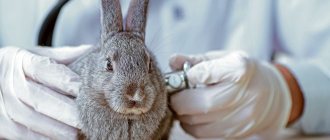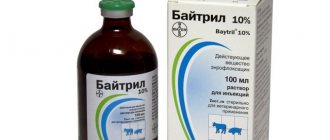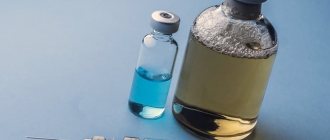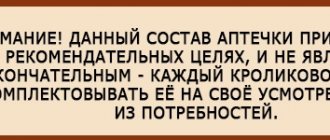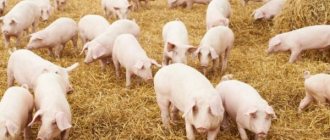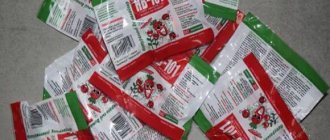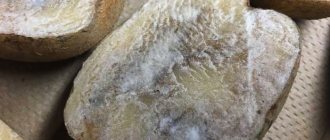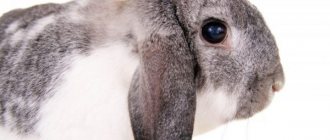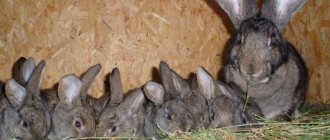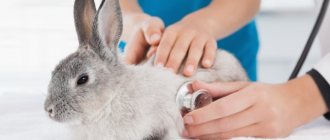VGBV and myxomatosis are terrible diseases that are considered a threat to the successful keeping of rabbits. The danger of these diseases is that they lead to the death of furry animals. The only way to save livestock from certain death is the Rabbiwak vaccine for rabbits. As a result of its use, animals acquire immunity to the myxomatosis virus and VGBV, which is why vaccination is so important for the successful breeding of animals.
Vaccination against VGBV
For the first time officially, hemorrhagic pneumonia in rabbits was recorded at the end of the last century in the DPRK. The disease is transmitted directly by sick animals. In addition, soil, water, feed and even humans are transmission factors.
Vaccination with the drug "Rabbivac-V" allows animals to acquire immunity and survive the epidemic
The incubation period lasts no more than 36 hours, after which the rabbit dies within 1-2 days. The RNA virus is highly virulent. It is resistant to low temperatures and immune to chloroform.
Vaccination with Rabbivac-V is the introduction into the body of an antigen that can increase immune defense to certain viruses.
Hemorrhagic disease - what is it?
Hemorrhagic disease, or HHD, is a highly contagious infection that kills 80 to 100% of rabbits and is only seen in these animals. This disease was first discovered in 1984 in China. Then the infected rabbits were brought to Italy, where the infection immediately spread throughout all regions, leading to the bankruptcy of many rabbit breeders. The wave of hemorrhagic disease reached Russia two years later.
The virus can be transmitted through soil, manure, water, feed, skin and fur of an infected animal. Rabbits can be infected through mice, rats, chickens and humans. This virus is not dangerous for humans, but rabbits are usually affected en masse. Adult animals and young animals older than three months are most susceptible to infection. Only vaccination can reliably protect your rabbits from infection. "Rabbivac-V" (instructions for use, doses and contraindications are given below) is an excellent remedy for solving this problem.
Composition and release form
During production, the virus strain is inactivated, as a result of which its basic properties are preserved, but the ability to reproduce is lost:
| View | Substance | Peculiarities |
| Inactivated strain | Vladimir-2000 | 1 immunizing dose contains ≥ 0.7 log2GAE |
| Adjuvant | 3% Al(OH)₃ | The compound promotes the production of immunocompetent globulins. |
| Preservative | 0.8% formalin | A solution used in many medical formulations. |
The vaccine is a light brown suspension with a suspended homogeneous substance. Available in glass containers up to 100 cm3. The number of doses varies from 10 to 100 pcs.
The product has no medicinal properties and does not cause any adverse reactions.
Rabbit V vaccine for rabbits: instructions, tips, review
Timely vaccination preserves the health and life of the animal, saves the rabbit breeder’s nerves and money.
VGBK - what is it and how to deal with it?
The abbreviation stands for “rabbit viral hemorrhagic disease,” and the birthplace of the infection is China, where the first sick animal was discovered in 1984. 2 years later, the epidemic covered Russia, throwing all rabbit breeders in the country into panic.
The most terrible discovery was that VGBV cannot be treated, and in 9 out of 10 cases, the unfortunate animals will die. The insidiousness of the disease lies in its asymptomatic course: the disease devours animals from the inside, and often the owners remain in the dark until the death of their pets.
The deadly virus is extremely tenacious and is transmitted to rabbits through food, water, and is carried on the clothes, shoes and hands of the owners. And although it poses no danger to humans, it attacks animals instantly. The incubation period lasts 2-3, maximum 5 days, and during this time all internal organs of the animals are affected.
The liver takes the first blow, then inflammation of the digestive tract and multiple hemorrhages occur, the kidneys and heart work to the limit, and as a result, pulmonary edema completes the tragedy: the animals die in terrible agony.
Symptoms appear a maximum of a day before death, but usually everything happens in a matter of hours: rabbits refuse to eat, become nervous, owners often observe convulsions, disorientation, and bleeding from the nasopharynx in their pets.
Often, infection with VGBV occurs simultaneously with myxomatosis, an equally terrible disease characterized by the formation of tumors and serous-purulent conjunctivitis.
After reflection, scientists came to the conclusion that treatment of such misfortunes is impractical due to extensive damage to internal organs. And prevention in this case is the only way to save animals.
Vaccination against VGBV
The causative agent of hemorrhagic disease is strong and merciless, its activity remains for 5 years, the virus is not afraid of frost and survives heat, so only a truly powerful agent that causes a persistent immune response of the body can resist it.
Scientists have developed the Rabbivac V vaccine for rabbits, and the production of the drug in Russia is carried out by a group whose activities are based on the production of veterinary drugs for animals.
The main purpose of vaccination is to introduce an antigen into the body that will help rabbits develop immunity to the disease, thus preventing possible infection. It is important to understand that a vaccine is not a cure and will not help infected animals.
According to the manufacturers in the instructions for use, the drug is absolutely safe for animals, but in rare cases an allergy may occur, which can be treated with antihistamines.
Prevention of hemorrhagic disease can begin in rabbits aged 1-1.5 months, and the animals must be absolutely healthy. It’s very easy to check your pet’s well-being; you just need to measure their temperature: readings from 38.5 to 39.5 degrees are considered normal.
If the rabbit has a fever, the procedure will have to be postponed, and the unhealthy animal will have to be isolated and, if possible, shown to a veterinarian.
Composition and release form
To produce the drug, a strain of hemorrhagic virus is used, which undergoes a special treatment - inactivation, as a result of which it loses its ability to reproduce, but retains its antigenic properties.
The production of the vaccine is located in the city of Vladimir, so the inactivated strain is called “Vladimir - 2000”. One dose of the drug contains at least 0.7 log2 GAE.
The second component of the composition is 3% aluminum hydroxide, the so-called adjuvant - a substance that promotes enhanced development of immunity. The preservative is 0.8% formaldehyde, an aqueous solution of formaldehyde widely used for the production of vaccines.
For ease of purchase, the drug is available in glass bottles or ampoules containing from 1 to 100 doses, with a capacity of 1 - 100 ml. The vaccine looks like a light brown suspension, and at the bottom of the bottle a loose sediment can be found, which, when shaken, turns into a suspended substance of a homogeneous structure.
Dosage and method of administration
A week before vaccination, it is recommended to deworm the animals, in other words, remove worms using any of these drugs:
- "Shustrik";
- "Albendazole";
- "Gamavit";
- "Pyrantel".
“Gamavit” in this case is the most effective, because one of its properties is additional support of immunity. Typically, the vaccine is purchased along with disposable syringes in quantities corresponding to the number of animals, and antiseptics are also stocked: wipes for injections or special alcohol solutions. If the procedure is carried out using reusable syringes and needles, the instruments must be boiled for 15 - 20 minutes.
"Rabbivac V" is strictly prohibited for use with other vaccines and serums.
Following the instructions, one animal will need 1 dose (or 1 ml) of the substance. Before use, shake the container with the drug thoroughly and draw 1 cube into the syringe. Rabbits can be vaccinated intramuscularly and subcutaneously, but experts consider the first method to be more reliable.
Dosage and method of administration
This composition is used only for disease prevention.
Be sure to read:
Ditrim: instructions for use in veterinary medicine, indications for use and doses
Efficiency depends on the accuracy of compliance with the instructions regulated by the instructions:
- A disposable syringe or one that has been sterilized for at least half an hour is used.
- The normalized dose is 1 cm3. Injected subcutaneously or into the posterior femoral region.
- The dry preparation is diluted with saline solution, as well as distilled water in the amount per dose:
- intramuscular injection – 0.5 cm3;
- subcutaneous administration – 0.2 cm3.
- The bottle is shaken until the contents are homogeneous.
The animal must have a live weight of more than 500 g and be at least 30-45 days old. Earlier vaccination does not give results. During this period, the body is not ready to form antibodies.
How to breed?
Before use, the vaccine is dissolved at the rate of one commercial (vaccination) dose of 1.0 ml of solvent (distilled water for injection). It's very simple.
- Let's look at how many doses of powder (lyophilisate) are in the bottle you purchased.
- We fill the syringe with a solvent at the rate of 1 ml per 1 dose (attached to the vaccine).
- Shake (draw up and release the suspension into the syringe several times).
- We collect the suspension in the volume that is needed, usually 5 or 10 doses.
- We put the drug as indicated below.
Efficacy and schedule of vaccination
The state of intense immunity is achieved by the animal’s body approximately 15-25 days after the vaccine enters the body. The vaccine is given once every 12 months.
The animal must have a live weight of more than 500 g, at least 30-45 days old
Features of vaccination:
- In farms with an unstable disease situation, revaccination is recommended.
- When quarantine is introduced in border areas, immunization is carried out quarterly.
- Violation of the vaccination schedule leads to a decrease in the effectiveness of preventive measures.
Females are vaccinated at any stage of pregnancy. The offspring obtained from them have passive immunity for 2 months from the moment of birth.
Brief characteristics of means for vaccination of rabbits
Rabbit breeders successfully use the drug Rabbivac, which today is available in three types.
Associated vaccine against viral hemorrhagic disease and myxomatosis - Rabbivac - VB.
The drug contains two ampoules - Rabbivac-B and Rabbivac-V.
The uniqueness of this combined vaccine is that it is complex, that is, its action is directed against the causative agents of two diseases in rabbits.
The associated vaccine Rabbiwak - VB is used for rabbits from one and a half months of age and for female rabbits. After three to nine months, vaccination is recommended to be repeated.
The first day after its administration, drowsiness and loss of appetite may occur. For twenty-one days, rabbits are provided with enhanced care and adequate nutrition. If the animal was infected before vaccination was carried out, it may die; it is harmless for healthy organisms. The vaccine has no contraindications. Meat can be used for food less than a month after vaccination.
Rabbiwak-V.
Dry vaccine Rabbivac-B is an effective remedy against myxomatosis. It contains the B-82 virus strain; thanks to its action, the drug has a clearly expressed preventive effect already on the 3rd day. The vaccine is light cream
Rabbiwak – V.
Vaccine against hemorrhagic viral disease Rabbiwak – V is light brown. The suspension may contain a slight sediment, which disappears with vigorous shaking.
Attention:
- Each rabbit is vaccinated intramuscularly with a separate sterile needle.
- It is better to start vaccination in early spring before the period when insects, especially mosquitoes, appear and become active.
- The vaccine is diluted with distilled water or saline.
- The vaccine retains its properties for two hours after opening.
The drug lapimune.
This is a preventive remedy for hemorrhagic disease; after its administration, it has an effect on the body for a year. Therefore, lapimune is recommended to be used only once a year.
An open bottle can be used for a week; injections are given intramuscularly using sterile syringes. The effect of the medicine begins on the 4th day from the day of administration.
To avoid complications, it is not recommended to administer lapimune simultaneously with other drugs.
Lapimun hemix vaccine.
The vaccine is a prophylactic not only against hemorrhagic disease, but also against myxomatosis.
Lapimun hemix strengthens the immune system and keeps it that way for about ten months, starting from the seventh day after its administration. Revaccination is recommended after eight months. Gemix is not recommended to be combined with other medications; at least two weeks should pass from its administration to deworming. Rabbits are vaccinated no later than seven days before the expected lambing.
The method of use and the procedure for mixing vaccine components are described in detail in the instructions, which must be strictly followed.
Vaccination for the prevention of pasteurellosis in rabbits.
Pasteurellosis occurs not only in rabbits and poultry, but even in humans. Therefore, the prevention of pasteurellosis must be taken very seriously. Rabbits get sick when they come into contact with each other; mice, insects, birds can become carriers of the infection, and the infection can be in drinking water. If an animal is infected, but under good conditions the disease does not make itself felt, it will manifest itself when immunity decreases and the animal will die. Symptoms of pasteurellosis often appear in rabbits when they change living conditions, when switching to other foods, etc. The mortality rate from pasteurellosis is high; several days pass from infection to death.
Veterinary medicine offers a wide range of medications for the prevention of pasteurellosis, the most common among them: “Formolvaccine”, “Pestorin Mormix” and others. You can vaccinate one-month-old rabbits; how many times you repeat the vaccination depends on the drug. To use it correctly, you need to carefully study the instructions and follow the recommendations.
In addition to vaccination, good prevention of pasteurellosis is compliance with sanitary and hygienic conditions in cages, the absence of rodents, and no contact with other animals or strangers.
Contraindications and possible side effects
The drug has no contraindications. According to statistics, after the strain entered the body, no side effects were identified in healthy individuals.
Vaccination requires subsequent careful monitoring of the herd:
- The skin at the site where the vaccine was administered may become inflamed. This process is not critical and gradually fades away.
- The use of immunizing compositions of different directions is possible with an interval of at least 15 days.
- It is strictly forbidden to vaccinate individuals:
- with helminthic infestations;
- infected;
- weakened;
- with clear signs of the disease.
- Cases of overdose have not been recorded, but if an allergic reaction occurs, symptomatic treatment with antihistamines is carried out.
There were no symptoms of VGBV, pathology when administering the vaccine to pregnant and lactating females, or any types of complications or side effects.
Be sure to read:
For what diseases is Mastiet Forte used in cows, dogs and cats, how to give
Vaccination scheme for rabbits against VGBV
Use by animals in the incubation period of the disease may cause their death.
Adverse reactions
It was not possible to detect any reaction from the animals’ body during an overdose of the drug. An allergic reaction to it occurs extremely rarely. If this does happen, it is necessary to refuse re-vaccination of the animal and carry out the necessary treatment. Rabbit meat can be eaten immediately after vaccination.
Storage and disposal
The bottles, like ampoules, are hermetically sealed, closed with stoppers with an aluminum retainer. Each package has a label indicating the manufacturer and date of manufacture.
Transportation and storage of the vaccine is carried out in a special container, which allows creating the conditions necessary for its safety:
- Freezing the drug is prohibited. Temperature within +2…+8 0С. Shelf life: 18 months.
- Keeping out of reach of minors. Proximity to food products is unacceptable.
- The use of the drug is not allowed if it has changed color or has been open for more than 60 minutes.
- The drug loses its properties at temperatures above +25 0C.
If the drug has expired, the ampoule or bottle must be boiled . It can be replaced by a half-hour treatment with chloramine (5%) or alkali (2%).
The disinfected composition does not require special conditions for processing.
Is it possible to vaccinate small rabbits?
There is an opinion that small rabbits should not be given the vaccine. In fact, it must be used starting from 45 days of age, since it is the only method of preventing infection. In addition, baby rabbits have a stronger immune system than adult rabbits, which allows them to develop lasting immunity to the pathogens of myxomatosis and VGBV.
You should not purchase an associated vaccine from clandestine companies, unknown persons or from hands, since such a drug may not work. It should be purchased only in well-established veterinary pharmacies, where the drugs are stored in compliance with all norms and regulations. At home, the vaccine must also be kept in compliance with its storage conditions - only in the refrigerator.
It is not recommended to use opened vials of vaccine; it is prohibited to use a drug whose expiration date has expired. It is necessary to get rid of such products by boiling them first.
If coccidia or worms were present in the animal’s body at the time the vaccine was administered, and prophylaxis to eliminate them was not carried out, the drug may be ineffective.
The vaccine package comes with instructions containing information on how to use the drug. The instructions indicate how to properly vaccinate rabbits; they must be followed. Only with this procedure will it be possible to achieve the desired effect with minimal risk to the animals.
There is no positive result if:
- during vaccination, the rabbits were in a weakened state and suffered from helminthic infestation or infection;
- there was an excessive attack of the pathogen, and the developed immunity could not cope with it;
- an expired vaccine was used or the vaccination schedule was violated;
- at the time of the procedure, the rabbits were already infected.
Advantages of complex vaccination for rabbits:
- cost reduction;
- optimization of the vaccination process;
- minimal risk of complications;
- increased level of protection against the most common diseases.
Expand comments
krolist.ru
Analogues and cost
Rabbit vaccination
The vaccine has a number of analogues produced by other companies. Despite the difference in composition, they also stop a dangerous disease.
| Name | Manufacturer | Approximate cost, rub/dose |
| Pestorin Mormix | Bioveta (Czech Republic) | 75 |
| Lapimun Gem | BioTestLaboratory (Ukraine) | 100-110 |
| Nobivak Myxo RHD | Intervet (Netherlands) | 55 |
The cost of the Rabbivac-V vaccine ranges from 33 to 70 rubles per dose.
Indications for use
The Rabbivac-V vaccine contains a strain of hemorrhagic virus, which helps to build immunity to the causative agent of the disease.
The importance of vaccination of animals is due to the danger of VGBV and myxomatosis. These diseases often result in the death of the entire livestock, and the causative agent of VGBV has an increased degree of survival in the external environment. Symptoms of hemorrhagic disease:
- convulsive twitching of the paws;
- the animal groans and throws back its head;
- bloody discharge from the nose.
Myxomatosis, like VGBV, often ends in mass death of animals. Symptoms of the disease:
- development of conjunctivitis;
- mucous membranes turn pale;
- body temperature increases to 41 degrees;
- hair loss;
- difficulty breathing;
- drowsiness and weakness, refusal to eat;
- Nodules may form on the ears and eyes.
Myxomatosis
Hemorrhagic disease
It is important to note that Rabbivac-V is not a medicine, therefore, in case of infection, administration of the drug will not cure the diseased animal.
Is the vaccine dangerous for humans?
Precautionary measures are similar to the safety rules when working with any veterinary products.
Instructions for use read:
- If the vaccine comes into contact with the skin, wash the skin thoroughly with soap and water.
- If the composition gets into a scratch or an accidental injection, you need to treat the area with ethyl alcohol, and then go to a medical facility. Carry the instructions for the drug with you.
- People must wear special clothing and have personal protective equipment.
- The drug that gets on the ground is neutralized with a solution of caustic soda or chloramine, which will not allow it to penetrate deeper.
Be sure to read:
How and why do veterinarians use Fosprenil, for what viral diseases?
Meat is allowed for human consumption and sale, regardless of the timing of vaccination.
Precautionary measures
When using the drug, increased safety precautions should be taken. Vaccination should be carried out only in special clothing, rubber gloves and boots, and safety glasses. If the substance gets on your skin, immediately rinse the area with running water. In case of contact with the ground, treat the area with a product containing alkali.
If the drug was inadvertently administered to a person, the injection site must be treated with a 90% alcohol solution and immediately go to the nearest hospital with a label of the administered drug.
Important! The use of
reusable needles and syringes is permitted only if they are previously sterilized by boiling for at least 20 minutes.
Contraindications
The use of the vaccine is prohibited:
- when using other immunostimulating drugs;
- if severe weakness is detected in the animal;
- if the rabbit has another clinical disease;
- earlier than two weeks after using other means of vaccination;
- if the rabbit is not dewormed before vaccination.
Side effects
The drug is quite safe and adverse reactions are very rare. The following side effects may occur:
- development of hemorrhagic disease in an animal (in case of overdose);
- manifestations of allergic reactions (rare cases).
Precautions when working with the drug
When using this substance, certain precautions must be taken. Before vaccination, it is recommended to wear special clothing. You should definitely use gloves. If the composition gets on the skin, it is important to wash it immediately with water. If a substance is inadvertently introduced into the human body, it is recommended that he consult a doctor. In this case, you must take the instructions for the medicine with you.
Expert opinion
Zarechny Maxim Valerievich
Agronomist with 12 years of experience. Our best country expert.
Ask a Question
Sometimes the substance ends up on the ground. This area should be treated with bleach. It is also permissible to use any alkaline composition. Such substances should definitely be on hand.
